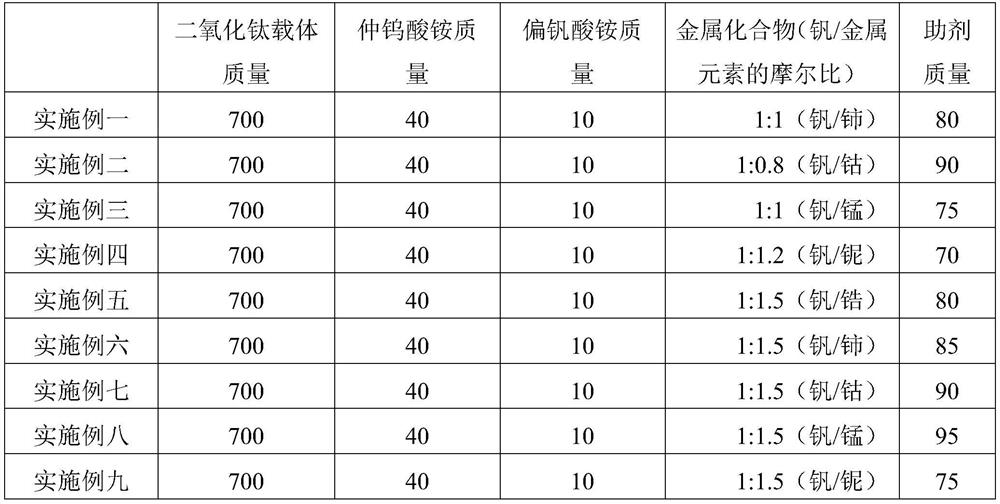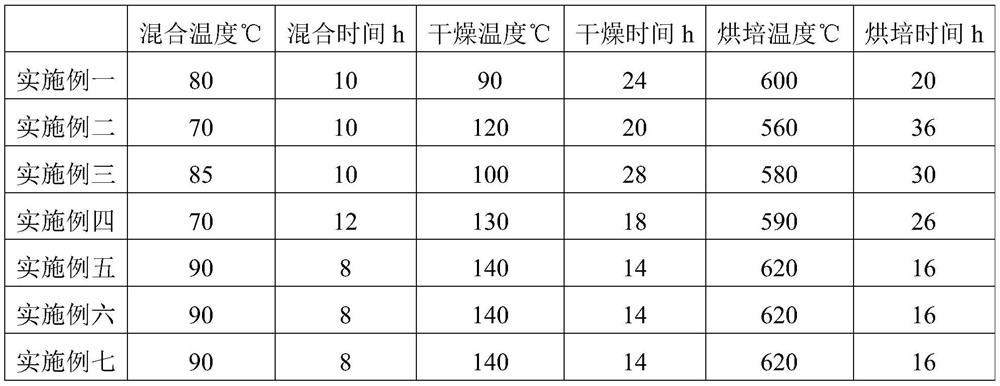Flue gas synergistic denitration and demercuration catalyst preparation method and catalyst
A catalyst and denitrification technology, applied in chemical instruments and methods, physical/chemical process catalysts, separation methods, etc., can solve problems such as flue gas conditions and formulation limitations, achieve synergistic mercury oxidation and removal performance, improve NOx removal efficiency, Efficient removal effect
- Summary
- Abstract
- Description
- Claims
- Application Information
AI Technical Summary
Problems solved by technology
Method used
Image
Examples
preparation example Construction
[0033] A method for preparing a flue gas synergistic denitrification and demercuration catalyst, comprising the following steps:
[0034] S1. Prepare raw materials, which include titanium dioxide carrier, active components and auxiliary agents.
[0035] The active component includes a vanadium-containing compound, a tungsten-containing compound, a metal compound or metal particles, and the mass ratio of the titanium dioxide carrier, the vanadium-containing compound, and the tungsten-containing compound is 70:4:1. The molar ratio of the metal element in the metal compound or metal particle to the vanadium element in the vanadium-containing compound is in the range of 0.8:1-1.5:1. in:
[0036] The tungsten-containing compound is selected from one or more of ammonium metatungstate, ammonium paratungstate, ammonium tungstate, tungstic acid, and tungsten trioxide, and ammonium paratungstate is preferred.
[0037] The vanadium-containing compound is selected from one or more of am...
Embodiment 1
[0044] S1. Prepare titanium dioxide powder, ammonium paratungstate, ammonium metavanadate, cerium nitrate, binder, stearic acid, kapok, and pore-forming agent, wherein the mass ratio of titanium dioxide, ammonium paratungstate, and ammonium metavanadate is 70:40:1, The molar ratio of vanadium to cerium in cerium nitrate is 1:1;
[0045] S2. Put the raw materials, ammonium chloride, and ammonia water in a mixing reactor and stir evenly and completely to form a mixture. The temperature of the mixture reaches 80° C., and the mixing time is 10 hours;
[0046] S3. Extrude the mixture in step S2, then dry at 90° C. for 24 hours, and finally calcine at 600° C. for 20 hours to obtain a catalyst.
Embodiment 2
[0048] S1. Prepare titanium dioxide powder, ammonium paratungstate, ammonium metavanadate, cobalt nitrate, binder, stearic acid, kapok, and pore-forming agent, wherein the mass ratio of titanium dioxide, ammonium paratungstate, and ammonium metavanadate is 70:40:1, The molar ratio of vanadium element to cobalt element in cobalt nitrate is 1:0.8;
[0049] S2. Put the raw materials, ammonium chloride, and ammonia water in a mixing reactor and stir evenly and completely to form a mixture. The temperature of the mixture reaches 70° C., and the mixing time is 10 hours;
[0050]S3. Extrude the mixture in step S2, dry at 120° C. for 20 hours, and finally calcine at 560° C. for 36 hours to obtain a catalyst.
PUM
 Login to View More
Login to View More Abstract
Description
Claims
Application Information
 Login to View More
Login to View More - Generate Ideas
- Intellectual Property
- Life Sciences
- Materials
- Tech Scout
- Unparalleled Data Quality
- Higher Quality Content
- 60% Fewer Hallucinations
Browse by: Latest US Patents, China's latest patents, Technical Efficacy Thesaurus, Application Domain, Technology Topic, Popular Technical Reports.
© 2025 PatSnap. All rights reserved.Legal|Privacy policy|Modern Slavery Act Transparency Statement|Sitemap|About US| Contact US: help@patsnap.com



